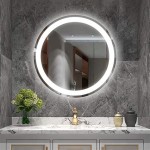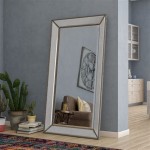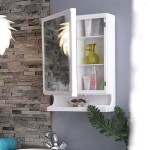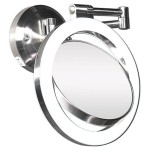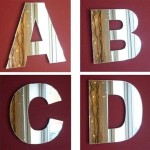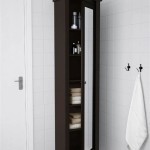Can You Hang A Mirror With Double Sided Tape? A Comprehensive Guide
Hanging a mirror can transform a living space, adding light, creating the illusion of more space, and serving as a decorative element. While traditional methods often involve nails, screws, and potentially wall anchors, double-sided tape presents an alternative approach. The viability of this method, however, depends on several factors, including the type of tape, the weight and size of the mirror, and the surface to which it will be adhered. A careful assessment of these elements is crucial to ensure a secure and lasting installation.
The allure of using double-sided tape lies in its ease of application and the minimal damage it inflicts upon walls. Unlike drilling, which can leave noticeable holes that require patching and painting, tape offers a cleaner, less intrusive option. This is particularly appealing for renters or individuals who prefer not to alter their walls permanently. However, it is essential to recognize that not all double-sided tape is created equal, and selecting the appropriate type is paramount for a successful mirror installation.
Understanding Different Types of Double-Sided Tape
The market offers a wide array of double-sided tapes, each designed for specific applications and possessing varying degrees of strength and adhesion. Standard double-sided tape, often used for paper crafts and light-duty tasks, is generally unsuitable for hanging mirrors due to its limited weight-bearing capacity. Attempting to use this type of tape for a mirror is likely to result in failure, potentially causing damage to the mirror and the wall.
Mounting tape, specifically designed for hanging objects, is a more robust option. This type of tape is typically thicker and features a stronger adhesive, allowing it to support heavier items. Mounting tape is often categorized by its weight capacity, indicating the maximum weight it can hold per inch or foot of tape. It is crucial to select a mounting tape with a weight capacity that exceeds the weight of the mirror to ensure a secure hold. However, even within the realm of mounting tapes, variations exist in terms of adhesive composition and suitability for different surfaces.
Heavy-duty mounting tape, often marketed as "permanent" or "industrial-strength," represents the strongest option available for hanging mirrors. These tapes are formulated with aggressive adhesives capable of bonding to a wide range of surfaces, including painted drywall, concrete, and tile. Heavy-duty mounting tapes are typically thicker than standard mounting tapes and offer significantly higher weight capacities. However, their aggressive adhesive properties can also make them more difficult to remove and may potentially cause damage to the wall surface upon removal.
Specialized mirror mounting tapes are also available. These tapes are specifically designed for adhering mirrors to various surfaces and often feature properties that prevent damage to the mirror's backing. These tapes may also be moisture-resistant, making them suitable for use in bathrooms or other damp environments. When considering using double-sided tape for hanging a mirror, it is advisable to prioritize specialized mirror mounting tapes or heavy-duty mounting tapes with a proven track record of success in similar applications.
Factors to Consider Before Hanging a Mirror with Tape
Before proceeding with hanging a mirror using double-sided tape, a thorough assessment of several factors is necessary to ensure a successful outcome and prevent potential damage or injury. The weight and size of the mirror are primary considerations. Larger and heavier mirrors require stronger tapes and may necessitate additional support, such as mechanical fasteners, to ensure stability. The surface to which the mirror will be adhered is also a critical factor. Smooth, non-porous surfaces, such as glass, tile, or metal, generally provide the best adhesion for tape. Porous surfaces, such as painted drywall or textured walls, may require surface preparation or the use of a primer to enhance adhesion.
The environment in which the mirror will be hung also plays a role in determining the suitability of double-sided tape. High humidity or temperature fluctuations can weaken the adhesive properties of some tapes, potentially leading to failure. In bathrooms or other damp environments, it is essential to use moisture-resistant tape to prevent the adhesive from degrading over time. The long-term stability of the tape is another important consideration. Some tapes may lose their adhesive properties over time, particularly when subjected to stress or environmental factors. Selecting a tape known for its longevity and durability is crucial for ensuring a lasting installation.
It's also important to consider the potential for removal. While the appeal of double-sided tape is the lack of permanent damage, the stronger tapes can still cause damage upon removal. Plaster walls, in particular, are fragile and can be easily damaged by aggressive adhesives. Carefully consider the wall surface and the potential for damage before committing to using heavy-duty tape.
Proper Installation Techniques for Hanging a Mirror with Tape
Even with the appropriate type of tape, proper installation techniques are crucial for achieving a secure and lasting mirror installation. The first step involves preparing the surfaces. Both the back of the mirror and the wall surface should be thoroughly cleaned with a mild detergent and allowed to dry completely. Any dust, dirt, or grease can interfere with the tape's adhesion, compromising its ability to support the mirror's weight.
Applying the tape correctly is equally important. Cut the tape into strips of appropriate length and apply them to the back of the mirror in a grid pattern, ensuring that the tape covers a significant portion of the surface area. Avoid placing the tape too close to the edges of the mirror, as this can create stress points and potentially lead to cracking or delamination. Press the tape firmly onto the mirror's backing, ensuring that it adheres properly.
Before adhering the mirror to the wall, carefully position it and mark its location. Remove the protective liner from the tape and carefully align the mirror with the marked location. Press the mirror firmly against the wall, applying even pressure across the entire surface. Hold the mirror in place for several minutes to allow the tape to bond to the wall. For larger or heavier mirrors, it may be advisable to use temporary supports, such as painter's tape or shims, to hold the mirror in place while the adhesive fully cures. Allow the adhesive to cure for the recommended time period, as specified by the tape manufacturer, before removing any temporary supports.
After the adhesive has cured, inspect the mirror to ensure that it is securely attached to the wall. Gently apply pressure to the mirror to test its stability. If the mirror feels loose or wobbly, it may be necessary to apply additional tape or consider alternative mounting methods. Regularly inspect the mirror for any signs of loosening or movement, and take corrective action as needed. Maintaining the cleanliness of the mirror and the surrounding wall area can also help to prolong the life of the adhesive bond.
While hanging a mirror with double-sided tape offers a convenient and less invasive alternative to traditional methods, a thorough assessment of the mirror's weight, the wall surface, and the environment is crucial. Selecting the appropriate type of tape and employing proper installation techniques are essential for ensuring a secure and lasting installation. By carefully considering these factors, individuals can successfully hang mirrors with double-sided tape and enjoy the aesthetic benefits without compromising safety or causing damage to their walls.

Tesa Powerbond Mirror 5m X 19mm Adhesive Solutions

Double Sided Tape To Hang Mirror

Double Sided Tape To Hang Mirror Best

How To Remove Hard Reach Double Sided Tape From The Wall Without Damage

Tesa Powerbond Mirror 1 5m X 19mm Adhesive Solutions

Double Sided Tape To Hang Mirror Best

3 Simple Ways To Hang A Mirror On Wall Without Nails Wikihow

Adhesive Double Sided Mirror Tape Tesa

Double Sided Tape To Hang Mirror Best

Tesa Powerbond 55733 Double Sided Tape For Mirrors Kalogiannis
